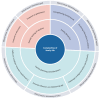Navigating family dynamics and ethical considerations in genetic diagnosis of pulmonary arterial hypertension: insights from in-depth semi-structured interviews
- PMID: 40129555
- PMCID: PMC11931558
- DOI: 10.1183/23120541.00698-2024
Navigating family dynamics and ethical considerations in genetic diagnosis of pulmonary arterial hypertension: insights from in-depth semi-structured interviews
Abstract
Background: Genetic diagnosis and precision medicine are rapidly advancing, driven by innovations in next-generation sequencing and omic methods. The UK's collaboration between national research initiatives and the National Health Service facilitates translation of research into clinical practice. This rapid transition impacts family dynamics and family planning, and raises ethical concerns, compounded by limited public and practitioner awareness of the long-term consequences of genetic diagnosis. Our objective is to explore the impact of genetic diagnosis on family dynamics and the ethical considerations of genetic testing at different life stages in patients with pulmonary arterial hypertension (PAH) and their at-risk relatives.
Methods: Stakeholders from the National Institute for Health Research BioResource Rare Diseases Study and the National Cohort Study of Idiopathic and Heritable Pulmonary Arterial Hypertension were recruited using purposive sampling. 53 interviews and focus groups with 63 participants were recorded, transcribed and thematically analysed using MAXQDA data analysis software.
Results: The study revealed three main themes: the impact of diagnosis on family dynamics, considerations for family planning, and genetic testing of relatives. Two attitudes toward testing offspring emerged: proactive advocates and gatekeepers. The gatekeeper stance was driven by three key factors: shielding children from genetic risk awareness, feelings of guilt or a desire to avoid blame for disease transmission, and limited family connections. Each theme highlighted various moral and ethical dilemmas faced by individuals.
Conclusions: A PAH diagnosis reshapes family roles and responsibilities. Genetic risk awareness strengthens bonds but also introduces challenges such as disclosing information and deciding on testing for at-risk relatives. Our research highlights the need for comprehensive genetic counselling and support systems to enhance patient care and familial wellbeing.
Copyright ©The authors 2025.
Conflict of interest statement
Conflict of interest: The authors declare no conflicts of interest.
Figures



Similar articles
-
Exploring Diagnostic and Therapeutic Odyssey in Pulmonary Arterial Hypertension: Insights from In-Depth Semi-Structured Interviews.Respiration. 2025;104(1):26-39. doi: 10.1159/000540556. Epub 2024 Sep 9. Respiration. 2025. PMID: 39250896
-
Exploring relatives' perceptions of participation, ethics, and communication in a patient-driven study for hereditary cancer variant reclassification.J Genet Couns. 2020 Oct;29(5):857-866. doi: 10.1002/jgc4.1215. Epub 2020 Jan 9. J Genet Couns. 2020. PMID: 31916645 Free PMC article.
-
Understanding what drives genetic study participation: Perspectives of patients, carers, and relatives.Pulm Circ. 2024 Feb 15;14(1):e12346. doi: 10.1002/pul2.12346. eCollection 2024 Jan. Pulm Circ. 2024. PMID: 38361979 Free PMC article.
-
Digital First Primary Care for those with multiple long-term conditions: a rapid review of the views of stakeholders.Health Soc Care Deliv Res. 2024 Jul;12(21):1-68. doi: 10.3310/AWBT4827. Health Soc Care Deliv Res. 2024. PMID: 39056123 Review.
-
Genetics of pulmonary hypertension in the clinic.Curr Opin Pulm Med. 2017 Sep;23(5):386-391. doi: 10.1097/MCP.0000000000000414. Curr Opin Pulm Med. 2017. PMID: 28661905 Review.
References
LinkOut - more resources
Full Text Sources
Research Materials
